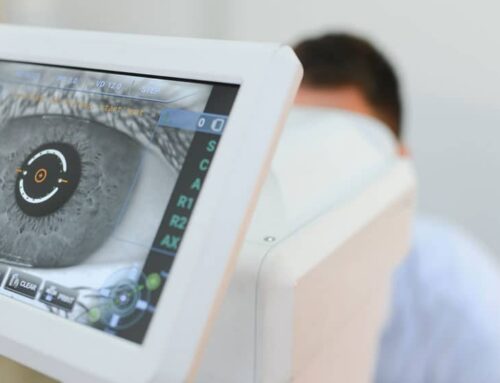Categories
Find A Surgeon
What Are Side Effects of LASIK?
LASIK eye surgery, known for its safety and efficacy in correcting vision, is a widely embraced refractive surgery. However, like any medical procedure, it comes with potential side effects. These can vary in intensity and duration, but are generally temporary. The most common LASIK side effects include:
- Irritation
- Glare and haloes
- Fluctuating vision
- Over-correction or Under-correction
Irritation
Mild discomfort or irritation is not uncommon immediately after the surgery. Everyone leaves their procedure with a scratch on the surface of their eye. This will feel “scratchy”. This typically usually resolves within a few days.
The eye drops used to prevent infection and inflammation can also cause irritation.
Dry Eyes
Temporary dry eye symptoms are common after LASIK. These symptoms can include irritation, scratchiness, burning, and foreign body sensation.
This symptoms typically go away as the normal inflammation and swelling resolve.
Long-term dry eye symptoms are uncommon. LASIK is trusted to many U.S. Military personnel every year. In a study performed at Walter Reed Army Medical Center less than 1% of patients had dry eye symptoms at 1 year following their LASIK procedure.
Glare and Halos
Glare and halos may be a short term side effect during the early healing process.
With older laser treatment patterns, glare and halos were more common than they are today.
With modern lasers, treatment plans, and optical zones, long-term glare and halos symptoms are uncommon.
Glare symptoms are most noticeable at night. A study of Navy pilots found that 99.6% of patients would recommend LASIK to others. Moreover, 88% of pilots reported their night vision after LASIK to be better than pre-surgery with glasses.
Fluctuating Vision
In the initial weeks following the surgery, some patients experience fluctuating vision. This is usually temporary as the eye adjusts to its new shape.
Under or Overcorrection
The goal is to always hit the bullseye perfectly. In some cases, the laser may leave leftover nearsightedness, farsightedness, or astigmatism. For most patients this can be addressed with a touch-up procedure a few months later.
Are LASIK Side Effects Common?
Mild, temporary side effects, such as irritation, are common after LASIK.
A large percentage of patients experience some form of side effects, but these typically resolve within days to weeks. The occurrence and severity of side effects can depend on various factors, including the patient’s pre-existing eye conditions, the technology used, and the skill of the surgeon.
Are There Risk Factors For Having Side Effects?
Part of the LASIK process is determining who LASIK is safe for. There are certain patients who should not have LASIK due to pre-existing risk factors.
Pre-existing Eye Conditions
Patients with severe myopia, dry eye syndrome, or other eye disorders may be more prone to experiencing side effects. Discuss your individual risk factors with your eye doctor.
Surgical Technique and Equipment
The type of vision correction procedure and the technology used can also influence the likelihood of side effects. LASIK technology has advanced considerably over the past 30 years. Modern technology has improved the safety and efficacy of the procedure.
How Long Will These LASIK Side Effects Last?
The duration of side effects varies. While most symptoms like dry eyes and glare tend to improve within weeks, some effects can take longer to resolve. In rare cases, certain side effects may persist, requiring additional treatment or management.
How To Reduce Your Risk of LASIK Side Effects
Choose an Experienced Surgeon
Selecting a highly experienced LASIK surgeon and laser eye center can significantly reduce the risk of complications.
Comprehensive Pre-Surgical Evaluation
Undergo a thorough eye examination to ensure you are a suitable candidate for LASIK.
Follow Post-Operative Instructions
Adhering to your doctor’s post-operative care instructions is crucial for a smooth recovery.
Maintain Realistic Expectations
Understanding the potential risks and having realistic expectations can help in better managing any post-operative issues.
Tips For Dealing With LASIK Side Effects
For Dry Eyes
Use lubricating eye drops as recommended by your doctor. There are many different types of artificial tears on the market. In general, a high quality, preservative-free artificial tear is best. Discuss which tears you should use with your surgeon.
Managing Glare and Halos
Wearing sunglasses during the day can alleviate discomfort from light sensitivity, glare, and halos. Making sure your eyes are well lubricated with artificial tears call help reduce any component of glare symptoms related to dryness.
Coping with Fluctuating Vision
Limit activities that strain the eyes, like prolonged screen time, and ensure adequate lighting while reading. Dry eyes is commonly the underlying cause of fluctuating vision. Discuss strategies for keeping your eyes lubricated with your doctor.
Regular Follow-ups
Attend all post-operative appointments to monitor your recovery and address any persistent side effects.
Conclusion
In conclusion, while LASIK eye surgery may have side effects, they are generally manageable and temporary. Understanding these side effects, their duration, and ways to mitigate them is crucial for anyone considering this procedure. By being informed and prepared, patients can navigate their LASIK journey with greater ease and confidence.
Remember, the key to a successful LASIK experience lies in choosing the right surgeon, being aware of the potential risks and side effects, and adhering to post-operative care instructions. With these measures in place, LASIK can offer a safe and effective solution to vision correction, improving the quality of life for many.
In addition to learning more about LASIK, review other procedures like other laser vision correction procedures, EVO ICL and Custom Lens Replacement (CLeaR) to learn if they are more suitable for your eyes.
About the Author Written by Dr. Michael Shumski, M.D., M.S.E.

Dr. Shumski is a board-certified ophthalmologist specializing in cataract & refractive surgery at Magruder Laser Vision in central Florida.
Related Posts
Related Posts

Choose The Right LASIK Surgeon
We provide the most accurate, comprehensive information about the best cataract surgeons in America, giving you the full picture of a provider’s qualifications.





